10 Ingredients To Elevate Your Bread Dipping Oil
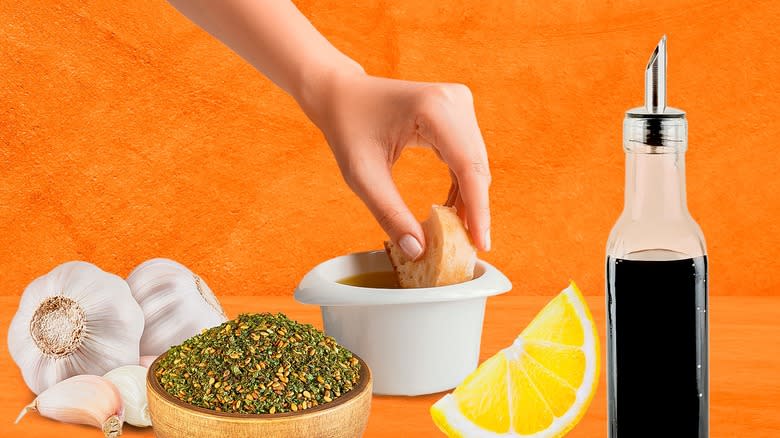
You may have come across bread dipping oil at a fancy restaurant during bread service, but not realized that you can easily make it at home to serve as an appetizer to guests, for your family, or as a delicious snack for yourself. If the thought of dipping your bread into oil sounds bizarre, you need to try it before you judge. You'll be amazed at just how appetizing it can be. In fact, many cultures around the world do this, and I personally grew up in my Egyptian household using herb and spice mixes like dukkah and za'atar along with olive oil. It was a flavor explosion and an easy way to satisfy the need for a savory snack. This is also really popular in Italian cuisine, where flavors of garlic and oregano or balsamic vinegar are added to olive oil to dip bread into at the start of a meal.
This high-impact offering takes very little effort to make and is an impressive way to start a meal. It doesn't require many ingredients, and you can easily customize it according to the flavors you love and what you have in your pantry or fridge. It also keeps well in the fridge so you can make it ahead of time and serve it when you need to. Paired with good, fresh bread, it is simply delicious. For some ideas, here are some of the ways you can elevate your dipping oil.
Read more: The 20 Best Olive Oils For Cooking
Use High-Quality Extra Virgin Olive Oil
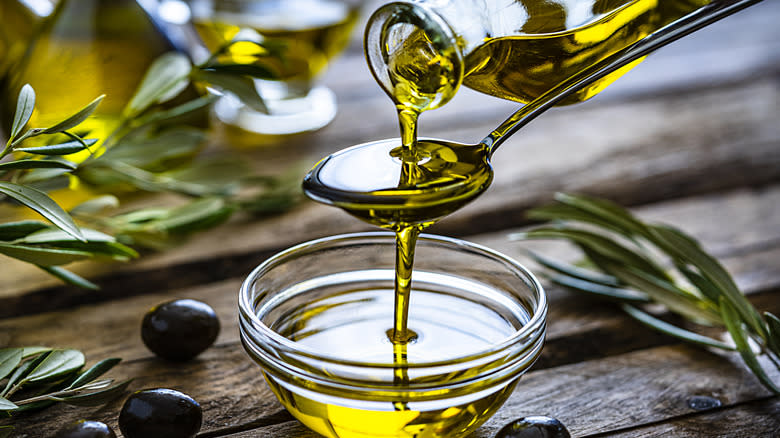
If you've ever made a bread dipping oil at home that doesn't taste quite as good as what you've had at a restaurant, you may be wondering what makes that other bread dipping oil so delicious. It's probably simpler than you think and usually comes down to using high-quality, fresh ingredients. The most important ingredient in your dipping oil is the oil itself. It may seem obvious, but many people tend to put their focus on the toppings than on the flavor of the olive oil. As the base for everything else, it's got to be high-quality olive oil that you love the taste of, even on its own.
However, not all olive oil is made equally. Some brands might even be mixed with other oils or use oil that's been extracted in a way that compromises on flavor. As a rule of thumb, go for extra virgin olive oil that's been cold-pressed.
Another thing to bear in mind is that olive oil can go rancid quickly, especially if you've opened the bottle and so exposed the oil inside to light and oxygen. If you don't like the taste of your olive oil on its own, it's worth checking the expiration or best-by date on the label. If you want more info on how long olive oil lasts after it's opened, it is typically still be fine to eat within six months. However, it may lose some of its flavor after about two months.
Sprinkle Some Za'atar
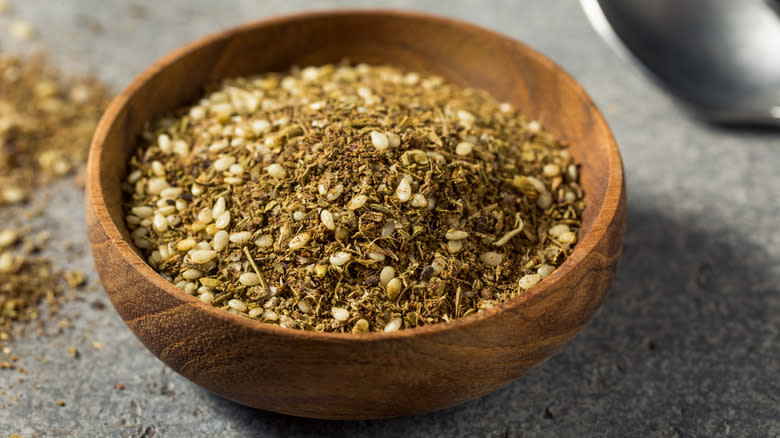
Some of the oldest traditions of bread dipping oil come from the Middle East and North Africa, in places like Lebanon, Syria, Jordan, Palestine, and Egypt. Za'atar is an herb blend that is customarily added to olive oil or on top of other foods like flatbreads, salads, and more. The exact recipes change not only between countries but also amongst households, with many families and sellers having their own secret recipe. It typically has a savory, nutty, and herbaceous character that helps to elevate bread dipping oil (and practically anything else) instantly,
Usually, the blend consists of herbs like thyme, marjoram, and oregano, as well as a herb also called za'atar, which is indigenous to the region and is similar in flavor to wild thyme. It's said to have been used since the times of ancient Egypt and even gets a mention in the Bible via hyssop, which some argue is a component of za'atar blends.
The other ingredients usually included in a za'atar blend are sesame seeds, which provide crunch and nuttiness, and sumac, which gives the mix a touch of tart flavor. These are the essentials, but many producers add other ingredients as well. And if you're buying za'atar or making a homemade za'atar blend, make sure the mix isn't so finely ground that it becomes a powder, as you still want a bit of bite and texture that is characteristic of this mix and dipping oil enhancer.
Experience The South Of France With Herbes De Provence
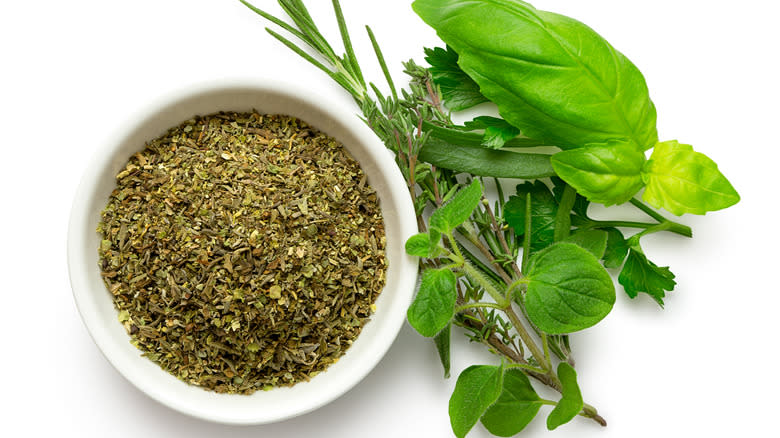
Herbs are a versatile ingredient that you can easily use to elevate your bread dipping oil, and certain dried blends like za'atar can instantly transport you to different places around the world. The same can be said for a mix called herbes de Provence, which hails from the south of France. This sunny Mediterranean region boasts bountiful produce and is known for its fine foods so it's no surprise that this herb blend is reminiscent of the flavors of the region and compliments olive oil (another thing commonly produced in Provence) especially well. It's incredibly easy to come by or you can even make it at home with herbes de Provence recipe
Like so many others, this mix differs depending on who's making it, but it will most likely contain dried herbs like fennel seeds, basil, thyme, oregano, tarragon, marjoram, rosemary, and mint. Some people add another touch of Provence to the mix with the use of dried lavender, the flower that grows in seemingly endless fields across the region and which can add a slightly floral element to your bread dipping oil.
However you might like this complexity, it's just as good to keep it simple and start with the basics, using a grinder or a pestle and mortar to process the herbs and smell the near-magical aroma. Then, simply add this mixture with a pinch of salt to your olive oil and dip your fresh bread right into it.
Go Classic With Balsamic Vinegar
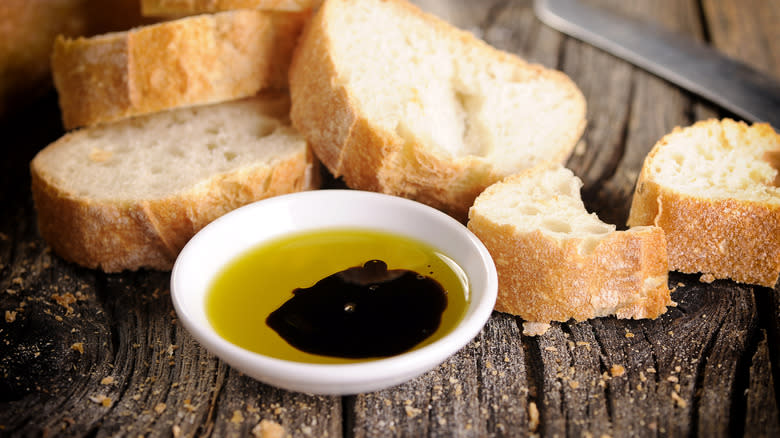
To many happy diners, the mix of balsamic vinegar and olive oil are a marriage made in culinary heaven, so it's likely that you've already come across this combo at an Italian restaurant, especially when it's been served alongside a generous helping of fresh, crusty bread. This is arguably one of the most common dipping oils in Italian cuisine. It's also one of the easiest bread dipping oil combinations to assemble, requiring just two ingredients you may already have in your pantry. The fruity yet acidic sharpness of balsamic vinegar cuts right through the oil, elevating both flavors, while the touch of sweetness of the vinegar rounds out the flavor especially well.
Keep in mind that, since you're only using two ingredients, there's nowhere to hide with mediocre products. So, make sure that you opt for good quality balsamic vinegar and olive oil to make sure this mix reaches its greatest potential. The bread you use will also play a role, meaning that freshly baked bread is really important to achieve the best overall experience. You can also add more flavor elements to this dipping oil via ingredients like grated parmesan, salt, freshly ground black pepper, garlic, and even briny capers. Whichever way you go, this appetizer will surely appeal to many diners.
Enjoy Salty Crushed Feta And Olive Dipping Oil
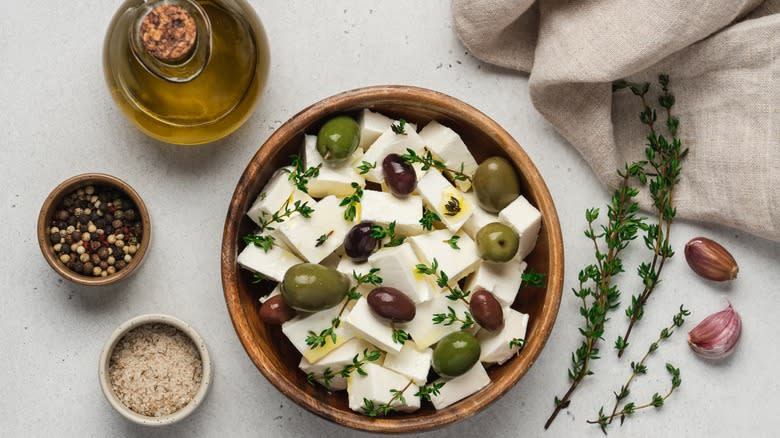
Another country with a strong bread dipping oil culture is Greece, making this Greek-inspired combo a win in many dishes, including pizza, salads, sandwiches,pasta, and, of course, bread dipping oil. Done right, a mix of feta and olives can achieve the perfect balance of salty and umami. With creamy feta, adding this combo to olive oil creates a beautifully rounded mouthfeel that, flavor-wise, breaks the saltiness slightly while creating a new level of richness. If you think adding olives to olive oil is overkill, the two taste different enough that you won't necessarily realize they are different parts of the same fruit. The two can also bringing out the complexity of both flavors even more than if they were served alone.
With olives, pick and mix between black and green varieties, as well as different herb mix they might have been infused with, and add-ins like garlic or chiles that can amp up the flavor of your dipping oil even more.
While you can add whole olives to your olive oil, along with cubes of feta, consider taking a little extra time to crush them with the back of a spoon or chop them roughly with a knife. This will allow the flavor of the olive to infuse even further into the oil, while making it easier to pick up olive bits with your piece of bread. This ensures you'll get all the flavors in every mouthful, too.
Dip Into Dukkah
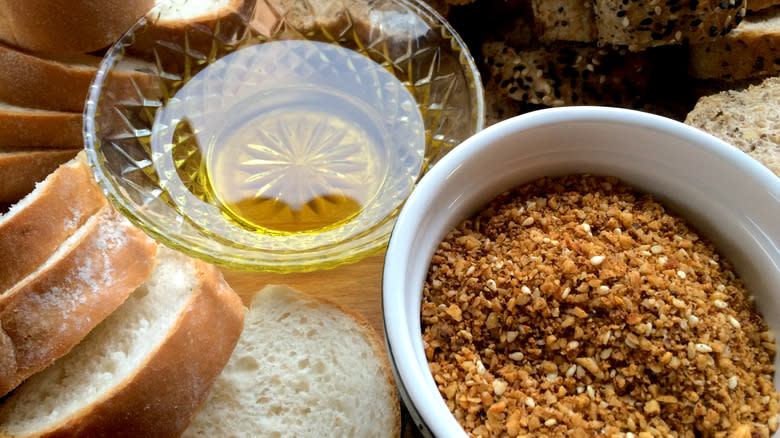
Dukkah is an Egyptian nut, spice, and herb blend, that's typically ground into an easily-sprinkled form. It's a salty flavor bomb and, along with za'atar, it's one of the sprinkles I grew up adding to bread dipping oil. It's so tasty and nourishing that sometimes it would be all we'd want for dinner as kids. It's as easy to assemble as it is flavorful, and will easily wow your guests or family. Dukkah mixes can differ but the most common ingredients include cumin, peanuts, sesame seeds, salt, nigella seeds, and ground coriander. All the ingredients are toasted, lending additional flavor and texture to the final dish.
As additional toppings, you can add chile powder, fennel seeds, other types of nuts like hazelnuts, cashews, or pistachios, as well as dried herbs like mint or thyme. All ingredients are ground into a coarse powder using a food processor or grinder. Add it straight to your oil or dip your bread in oil and then sprinkle dukkah on top.
If you want to use it as a seasoning, feel free to grind the mix to a finer consistency, but keep in mind that the bite is part of what makes dukkah so delicious. Beyond its presence in dipping oil, it can also be used as a dry rub for roast meats, potatoes, and fish and can be sprinkled on salads as a crunchy, spicy topping. Making a jar at home will have many uses beyond your bread dipping oil.
Salivate Over Parmesan And Garlic Dipping Oil
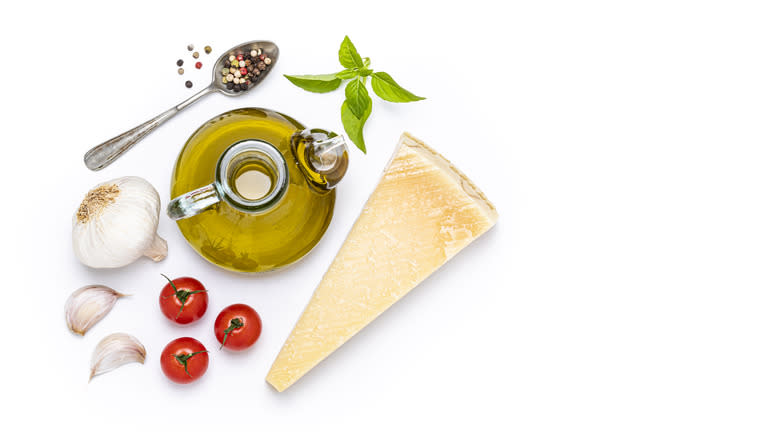
Another Italian restaurant classic is an olive oil bread dip that's been infused with garlic and sprinkled with parmesan. And while it may be a childhood favorite from your family's go-to chain restaurant, there's nothing run-of-the-mill about it, especially if you take extra measures at home and use fresh ingredients. Do that and it could elevate your bread dipping oil experience tenfold.
One tip is to grate the parmesan yourself, as pre-grated parmesan can be dry and flavorless. Another is to use fresh garlic, rather than buying a garlic-flavored oil. While pre-infused oil may seem like a nifty shortcut, nothing beats the flavor of making your own infusion. To do this, simply mince garlic and add it to your oil. The longer you leave the garlic to sit, the more its flavor will be absorbed into the oil, making it ideal to assemble ahead of time and keep in the fridge.
If you don't enjoy the fiery nature of fresh garlic, apply low heat to your oil and garlic cloves, leave it to infuse for 15 minutes, then remove the cloves, which should result in a milder garlic flavor. You can also roast a whole head of garlic, squeeze the soft cooked garlic cloves into the oil with the parmesan, and mush it all together with a fork. Because roasted garlic is fairly mild, you should be able to enjoy it without the resulting fire breath.
Maximise Freshness With Lemon Zest
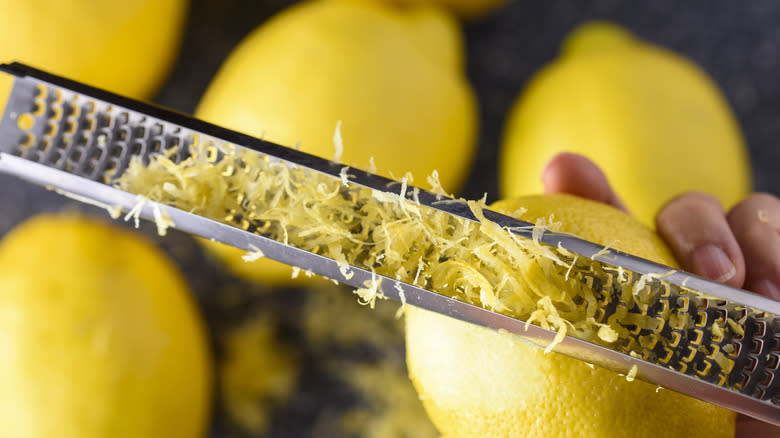
Many recipes for bread dipping oil advise you to add an acidic component like vinegar or lemon juice, either of which can help to cut through the rich, viscous oil. Yet lemon juice doesn't always fully impart the wonderful fragrance of the lemon fruit. This is where lemon zest comes in. Zest contains much of the vibrant fruity flavor via the oils contained in the skin, which integrate well into the olive oil and result in a beautifully-perfumed dipping oil that will easily elevate your dining expeience.
Lemon zest is sure to add a pleasant freshness and elevate any recipe of dipping oil, though you should take care to pay attention while you're preparing it. Zest the peel of the fruit with the fine grating side of your grater or a zester, being careful to avoid incorporating too much of the bitter white pith beneath the yellow skin.
You can also cut up preserved lemons that have been preserved whole, which will add an extra sharp and bitter element to your dipping oil. This is particularly suitable if you're using other Middle Eastern or North African spices and herbs, as preserved lemons are often used in these culture's cuisines. For a slightly sweeter take, chop up candied lemon skins. This a surprisingly delicious way to incorporate lemon skin and zest into your oil.
Increase The Heat With Chile Oil
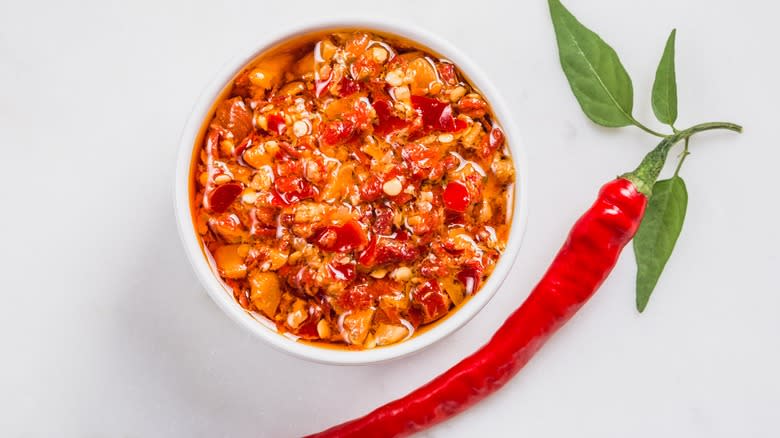
Chile has long been a favorite ingredient for infusing oil, especially in Chinese, South Asian, and African cuisines like that of Mozambique, where adding chile-infused oil is a regular feature on the table in mixes such as piri-piri sauce. You can easily infuse your own bread dipping oil at home, adding either freshly chopped chiles into your oil or allowing the flavors of oil and chiles to merge in a pan that's been set over low heat for a few minutes.
A great shortcut is to add store-bought chile crisp or chile oil to your olive oil, and adjust the quantities according to the level of spice you enjoy. You can also get away with adding hot sauce to your oil, though it's probably best to do so in small quantities.
Consider the specific types of chiles you enjoy, thinking about different varieties as well as preparations like dried chile flakes or powders. The heat of chiles tends to get stronger the longer you infuse it in the oil, so if you like things to be especially spicy, you can benefit from making a big batch and keeping it for months. But if you prefer a milder kick, make a smaller amount to both cut down on the heat and avoid food waste.
Add Zing With Chermoula
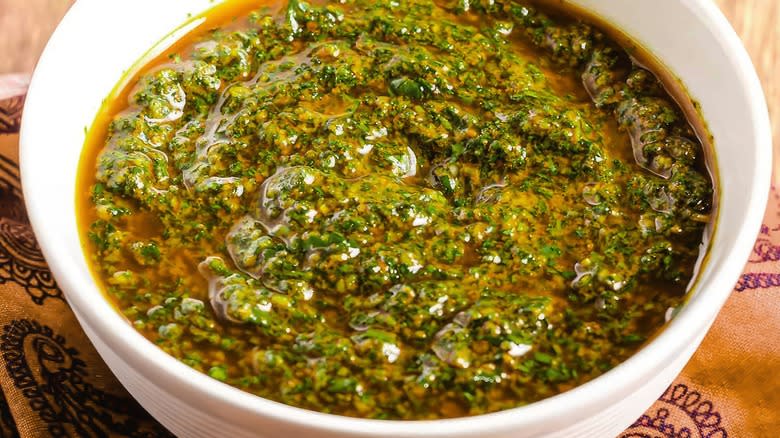
The zingy and flavor-packed sauce known as chermoula is the North African cousin of other green sauces such as salsa verde and chimichurri. To many, it's the epitome of an elevated bread dipping oil. It's got spices, garlic, herbs, peppers, lemons, oil, and more. The condiment originates from North Africa, where it's a catch-all way to add incredible flavor to anything. It's served on meat and fish, as well as insandwiches, stews, and salads. It's also often used as a bread dipping oil.
Common ingredients include olive oil, fresh ginger, preserved lemon, fresh garlic, fresh-cut chiles or dried chile flakes, spices like cumin and paprika, and fresh herbs such as parsley and cilantro. You can easily customize it using dried or fresh versions of the ingredients mentioned, or according to what's in your pantry.
While preserved lemons give chermoula its character, don't sweat it if you can't find some. Instead, you can sub in fresh lemon. Remember to use both the juice and the zest for full flavor. Whatever ingredients you use, always taste along the way and adjust for acidity, spice, and saltiness. Traditionally, chermoula is made by hand using a mortar and pestle, but it easily comes together in seconds with the help of a blender or food processor.
Read the original article on Tasting Table.

